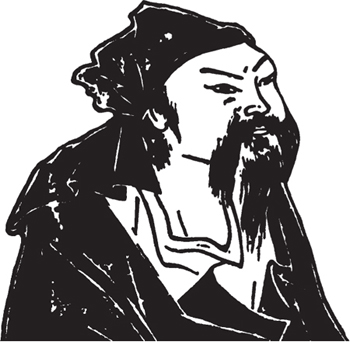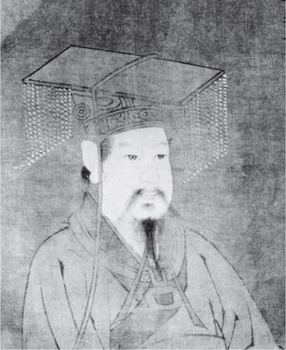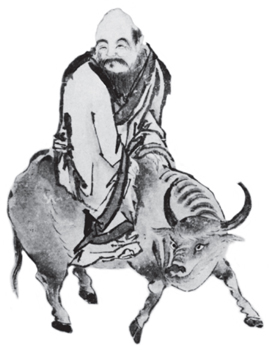
TAOIST LONGEVITY PRACTICES
|
|
TAOIST LONGEVITY PRACTICES |
Throughout history, Taoists have propagated the development and restoration of the human body, breath, and spirit. They call these the Three Treasures (san pao): ching, qi, and shen, corresponding in simplest terms to body, breath, and spirit. The human body results from the culmination of sexual forces, or ching, is animated by the vital force of qi, and made conscious through the activation of shen. By preserving the Three Treasures, Taoists believe that people can achieve optimal health and longevity and also create within themselves the alchemical gate to immortality.
The Arts of Nourishing Life
Three practices dominate the Taoist quest for health, longevity, and immortality. The first is the ingestion of herbal medicines (fu erh) and the purification dietary regimes. The second is the performance of physical and respiratory exercises (t’u na) to gain breath control and mobilize the qi. The third practice is the achievement of mental and physical tranquility through meditation (ching tso). If one or more of these three practices can be maintained in your daily life, you will at the very least restore your vitality and stamina (having youthfulness in old age). Depending on the depth and sincerity of your efforts, you could attain longevity (living to over one hundred years of age in good health) or actually discover the elixir of immortality.
Many Taoists consider longevity (shou) to mean the ability to experience youthfulness in old age and to live in good health to the end of one’s days. Sickness prevents practitioners from putting all their effort toward immortality, and death ensures failure. The notion of living beyond one hundred years of age has always been considered a milepost of sorts, proving to everyone that your art and teaching have merit.
The term corresponding to immortality (hsien) literally means “man in the mountains.” The idea is of a hermit seeking complete absorption into nature. Many schools of Taoism, however, do believe and propagate the idea of actual physical immortality. The most widely accepted meaning contends that when the practitioner dies, the mental and spiritual energies remain intact after death; in other words, the practitioner remains completely conscious during the death experience. In Taoist terms, the heavenly spirit (hun) remains, while the earthly spirit (p’o) is shed.
In order to preserve the Three Treasures and forge the elixir of immortality, Taoists developed physical and respiratory exercises that originally were placed under the general heading of arts of nourishing life. The entire basis for what is now popularly called qigong began with the simple experiment of healing with the breath, which in turn led to the discovery of qi energy itself.
Qi literally means “breath” and “vital energy.” The term is one of the most extensively used in the Chinese language, and is applied to anything which incorporates the idea of energy, such as t’ien qi, meaning “heaven’s breath” or more simply “weather.” But for the purpose of this material the qi referred to is contained within the idea of the vital energy, which both sustains life and animates it. Qi to the Chinese mind is the very energy that allows us to be mobile and active. The main source of qi is in our breath, wherein we are constantly breathing in qi.
The qi is also contained within meridians (energy pathways) and cavities of the body. When we learn to fully stimulate and awaken this energy, our bodies take on a new and heightened sense of vitality and power. We can access our qi in much the same way that we can access the power of steam to run a steam engine. Actually, in the Chinese the character for qi refers to the steam coming off the pot of cooking rice.
Through the stimulation and accumulation of qi a person may not only acquire a new sense of physical and mental energy, but create the conditions of longevity as well. Hence, there are numerous practices under the heading of qigong. But the Eight Brocades is actually the earliest regime of qigong; all others styles or practices created since have basically borrowed from the methods of the Eight Brocades.
In order to fully mobilize the qi throughout the body, one must first accumulate it in what is called the tan-t’ien (Field of Elixir). This tan-t’ien is a point in the lower abdomen about three inches below the navel and one inch back into the body. This area, normally called a “qi cavity,” is not real in the sense of being something substantial; it is a mentally produced area at which a person feels his or her center of being. When the qi is felt there, usually by sensations of heat and vibration, it is also possible to circulate it and feel it move physically up along the spine, over the head, and back down into the tan-t’ien again. It is this very mobilization of qi that every Taoist aspires to. When nine complete circulations can be accomplished in one sitting, what is called an “immortal fetus” is produced. This immortal fetus is one’s spiritual body, or “qi body” as it is sometimes referred to. In brief, immortality is achieved.

Chuang-tzu
The Taoists are not alone in their theory of qi. Similar theories are seen in yoga practices (where qi is called prana) and in various other religions and philosophies as well. But all of these theories originate in the breath, which is why the term qigong itself means “skillful breathing.”
Through simply breathing in deeply and then focusing the exhalation and visualizing the breath expelling through the location of the pain or affliction, the early Chinese discovered not only a great healing power but an internal energy as well. Later terms for the practice of these exercises included t’u na (literally to spit out and take in), hsing qi (moving the qi), pi qi (holding the qi), tao yin (leading and stimulating), yun qi (circulating the qi), hsiao chou t’ien (the Lesser Heavenly Circuit), and the “skillful breathing” that is now generically referred to as qigong (a more literal meaning would be “exercising the qi”).
The terms t’u and tao yin first appeared in chapter fifteen of Chuang-tzu (named after its author, who lived circa 369-286 B.C.), where it says:
Breathing in and out in various manners, spitting out the old and taking in the new, walking like a bear and stretching their necks like a bird to achieve longevity—this is what such practitioners of tao yin, cultivators of the body and all those searching for long life like Ancestor Peng, enjoy.
Tao in combination with qi means “guiding the breath,” and yin used with qi means “to stimulate the breath.” The premise of tao yin then is physical movement done in conjunction with the breath in order to mobilize the qi throughout the body. The meaning of this term goes far deeper, however, than this simple definition.

Peng-tzu, an ancient immortal who reputedly lived during the Shang dynasty (1766 B.C. to 1154 B.C.). The Book of History1 lists him as having lived over eight hundred years.
At Ma-wang-tui near Ch’ang-sha in Hunan Province, a large length of silk from the early Han dynasty (approximately 206 B.C. to 23 B.C.) was discovered in an unearthed tomb. Painted on this silk were forty-four figures clearly performing tao yin exercises, and so it was given the name Tao Yin Tu (tao yin chart). A series of the drawings were prefixed with the word yin, but here the meaning is to “induce a cure.” So the early meaning of tao yin appears to have been “leading the breath to induce a cure.”
In his discourses on Chuang-tzu, Li Yi, an early Han dynasty Taoist, describes tao as the process of “guiding the breath to make it harmonious” and yin as “leading the body to become soft.” Soft carries many meanings, such as flexible, pliable, open, relaxed, sensitive, alert, and so on. It is through softness, the elimination of tension, that qi is able to freely move about the body through the meridians and collaterals, which is precisely what hsing qi refers to.
The earliest known appearance of hsing qi is on the handle of a staff unearthed in Shantung Province, dated circa 380 B.C. The inlaid jade inscriptions, in referring to the purpose and ensuing sensations of stopping the breath (pi qi), speak of the mobilization of breath, or hsing qi.

Emperor Huang Ti
Hsing qi as a Taoist practice developed from the Huang ti nei ching (The Yellow Emperor’s Classic of Internal Medicine), a medical book that appeared sometime during the third century B.C. but that presents itself as a set of teachings created for the Yellow Emperor (who ascended the throne in 2697 B.C.). In the chapter on “Plain Questions,” we find the instructions for what Taoists came to call tortoise breathing (kuei hsi, literally “swallowing the breath”):
Breathe deeply seven times, each time stopping the breath qi extending the neck, and then swallowing the breath. It should be done as if one is swallowing something hard. Having done this seven times, move the tongue around and swallow the saliva that is produced several times.
About six hundred years later, Ko Hung, a fourth century A.D. Taoist alchemist adept and writer, reports that his uncle, Ko Hsuan, would sit at the bottom of a pond holding his breath for almost an entire day when the summer heat was too unbearable. This is an indication that Ko Hsuan was very adept at stopping the breath.
In many instances in his work Pao-p’u-tzu, Ko Hung advocates these types of breathing for the attainment of longevity and immortality.

Ko Hung
Abdominal Breathing
Ancient Taoists were great observers of life and its functions, especially of the process of continual dissipation and the rising of the breath during a person’s life. When we are newly born, barring any problems created during the pregnancy, we are at our all-time best. Every day thereafter becomes a race toward death. We all start out in life with our breath very low in our abdomen, and our entire body breathes. As small sleeping babies, we breathed perfectly. Our bodies were warm and rosy colored, and our hands and feet received a strong, continuous supply of blood.
The problem is that as we get older we become conscious of the state of our health; as young children, contrarily, we are not conscious of it. In fact, we have no thoughts of good or bad health as children. As we grow older, we start to deal with anxiety, tension, responsibilities, sex, money, emotions, and so on—all of which cause our breath to rise. Our breath moves from the lower abdomen to the upper abdomen and into the lung area. Between the ages of thirty and fifty, most of us maintain our breathing in the solar plexus region. In our sixties and seventies, it rises to the lung area. If we are fortunate enough to die a natural death, the qi departs from the body with one last gasp for air.
Men in their old age will, generally speaking, acquire a “bird’s chest” from accumulated air in the front upper lung area. This is the nature of the yang in men. Because of this, men lose their central equilibrium in old age, stumbling and wobbling with a body that is top-heavy with air. Their center of balance lies in the upper front lung area, which causes a slight leaning up and back.
Women, on the other hand, can acquire the “willow back” in their senior years from accumulated air in the upper back of the lungs. This is the nature of yin in women. The weight of the air is attracted to the upper back lung region, causing the spine and head to bend forward as if they were carrying a great weight on their backs. Since these are general trends and not true in all cases, some men, depending on their nature (yang or yin), can acquire either the bird’s chest or the willow back; and so too for women.
Although it might look similar, the willow back should not be confused with what the Taoists call the “tortoise back,” which is the result of the proper internal application of mobilizing qi through the Lesser Heavenly Circuit. If people can manage to keep their breath low throughout their entire life, they will probably not suffer from the negative conditions of the bird’s chest or the willow back.
Ancient Taoists, who observed this pattern of the breath rising during a person’s life and the final exit out the mouth at death, concluded that if a person is to attain longevity and perfect health, then the first rule is to restore the breath to the lower abdomen, where infants breathe. Lao-tzu, in his classic the Tao-te ching, asks, “Can you attain the pliability of a child?” He also states that “the entire secret of self-cultivation lies in subtraction, not in addition.” This means that we must reverse our thinking, habits, and ambitions in order to preserve our health. Almost everything concerning Taoism focuses itself on returning to a state of youthfulness. Don’t confuse this idea, however, with the Western infatuation with looking young.

Lao-tzu
Taoists value an aged person who is still vital and young in mind far more than someone in his or her youth. The reason and wisdom that come with age are what is valued. A common phrase in all Taoist works is chang sheng pu lao, which in literal translation would be “living long with no aging.” More correctly, it means “youthfulness in longevity.”
Enjoying youthfulness in old age, and thus prolonging life itself, is the first goal of Taoism because it renders more time for the refinement of the elixir and the attainment of immortality. And to undergo the rigors of self-cultivation one cannot afford to be sick or to lack vitality. Taoism’s main tenet of returning the breath to the lower abdomen where it was when we were children makes perfect sense whether you are searching for good health, longevity, or immortality.